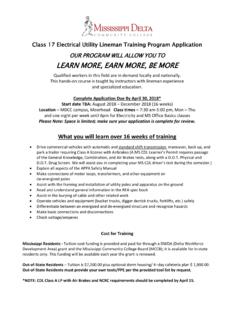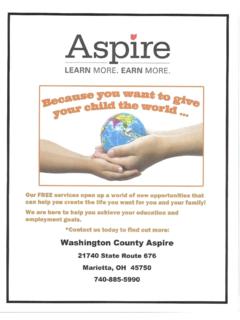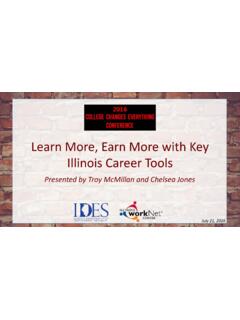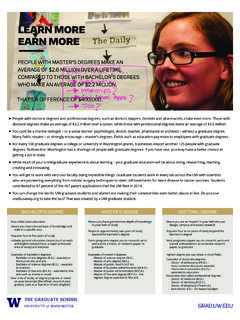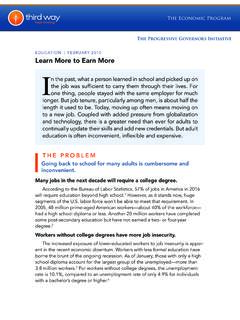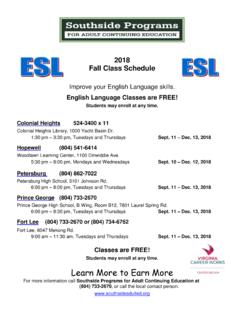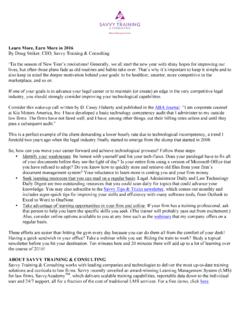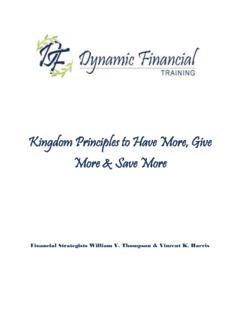Transcription of LESSON NINE LEARN MORE, EARN MORE - myfinanceclass.com
1 LEARN more , earn more A Tale of Two Techniques This is the story of Juan and Carlos. Both boys loved the game of basketball almost more than anything else. When they were young, their parents would have to drag them off the court when it got dark. As they grew up, the two friends were inseparable. They were at the court, working on their game, every opportunity they got. And it paid off. They were good really good. Their high school team took the state championship, and both were named to the All Star team. Life was good. Juan knew that as much as he loved basketball, he had to get an education as well, so he studied in high school and even took some advanced classes to prepare him for college.
2 He also loved music and somehow found time to LEARN to play the piano. Jazz was his favorite, but he could do a real number on classical compositions. Central State College was impressed, mostly with his athletic ability, and offered him a full scholarship, which included basketball. Life was good. Juan thought his major in business and finance would help him manage all the money he planned on making once he hit the pros. He enjoyed his minor in speech and public relations. After all, working with the public would be a useful skill after his years in the NBA, he reasoned. Juan's college athletics were promising, as he avoided injuries and played all four years. In college, he received expert coaching, competed on a much higher level than in high school, and had a chance to practice and perfect his craft.
3 But, despite his talent and desire, he just wasn't good enough for the pros. Juan was disappointed because his dream had always been to play in the NBA. But now he had a college degree, other skills and interests, an engaging personality, and a network of friends. He was offered and accepted a good job upon graduation. He still plays hoops with friends and coaches in the community center, but his job and family don't leave him a lot of spare time. Life is busy, but it's good. Juan runs into Carlos occasionally. Carlos did OK in high school during the marking periods needed to maintain eligibility for basketball, but for the rest of the time he neglected his studies. All he wanted to do was play basketball and get better and better so he could play for the pros.
4 He figured that with a pro's salary, he wouldn't need an education. Unfortunately, Carlos' grades were too low to get him into college, although he was an excellent athlete even better than Juan. He kept hoping for a break, but it didn't happen. He could have been good at a lot of jobs, but he didn't have an education. When Juan and Carlos talk, Carlos seems to be between jobs or just working until something better comes along. Life is not so good. 1. List the investments each made to his own human capital. 2. How did the investment payoff for each? 3. Which one was better equipped to handle the future? Why? 4. How does this comparison illustrate the idea of diversification? LEARN more , earn more Human Capital refers to the knowledge, skills, and experience that people bring to the workplace.
5 With education and training, people increase their human capital and improve their productivity, which usually allows them to increase their income. Take a look at the following charts, and answer the questions that follow. Education and Income (Age 25 and Older) EDUCATION LEVEL AVERAGE ANNUAL INCOME Male Female Total Population College graduate (bachelor s degree or higher) $72,020 $54,548 $62,036 Some college or associate s degree $45,344 $34,372 $39,572 High school graduate $39,052 $30,056 $35,776 Not a high school graduate $26,884 $21,268 $25,376 Total Population $47,944 $39,104 $43,628 Unemployment Rates By Years of Education (Age 25 and Older) Workers By Highest Level of Education: YEAR All workers Not a high school graduate High school graduate Some college or associate s degree College graduate (bachelor s degree or higher) 2016 2015 2014 2013 2012 2011 2010 5.
6 Why do some individuals earn more money than others? 6. What relationship exists between workers level of education and unemployment rates? 7. What relationship exists between the earning power of men and women? What would explain this? 8. Why might individuals with the same level of education earn different incomes? LEARN more , earn more Average Annual Expenditures Income Range $10,000 to 14,999 $30,000 to 39,999 $70,000 and over Average income before taxes $12,888 $34,752 $134,382 Taxes paid $(454) $410 $22,831 Average income after taxes $13,342 $34,342 $111,551 Average annual expenditures $21,956 $37,019 $86,681 Expenditure type Amount % of Income Amount % of Income Amount % of Income Food $3,362 $5,090 $10,084 Housing $8,889 $13,296 $26,954 Personal care products & service $258 $444 $997 Utilities $2,349 $3,370 $5,229 Housekeeping supplies $296 $503 $994 Apparel & services $693 $1,233 $2,860 Gasoline & motor oil $1,194 $2,246 $3,744 Vehicle purchases $746 $2,283 $5,866 Health care $2,046 $3,285 $5,797 Entertainment $963 $1,595 $4,524 Life & other personal insurance $66 $206 $630 Pensions & social security $576 $2,102 $11,984 9.
7 As the level of income goes up, what happens to the actual amount consumers spend on items such as food, housing, utilities, entertainment, transportation, and health care? 10. What happens to the percentage of personal income spent on these items? Why? 11. What is the relationship between the amount and percentage of income spent on pensions and Social Security across all three groups? 12. What is the relationship between income and average annual expenditures for the three groups? How can this happen? 13. Given this information, what could we conclude about the standard of living as incomes rise? 14. This data does not give us any information on the level of education for members of the three groups.
8 Based on what you have learned in this LESSON , what would you predict the education level would be for individuals in these groups?
